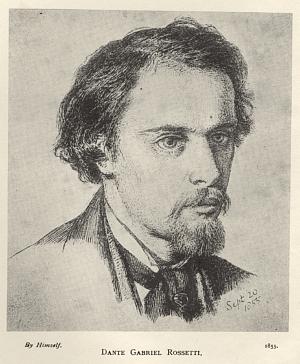Rossetti's 'For Our Lady of the Rocks": An Examination of Pre-Raphaelite Beliefs
Vilayath and Lance

Dante Gabriel Rossetti
|
The ekphrastic poem acts as a literary medium for a visual piece of art. The poet chooses to convey not only their interpretation of the visual, but their perspective of the sensual feelings from the work as well. ‘Choice’ is an important word to note because it highlights the fact that the poet includes and excludes certain information about the visual work that they feel is important in order to convey a particular reading; it is not simply a regurgitation of the visual work in literary form. This ‘choice’ is very important to understanding Rossetti and his Pre-Raphaelite Brotherhood. The Pre-Raphaelites challenged the established “academic” understanding of visual art, an understanding that succeeded the artist Raphael, hence their name Pre-Raphaelite. They felt the common and frequent compositions, which many artists of their time worked according to, numbed the public to accept this stale and stationary position in which visual art was stuck in. The brotherhood formed from individuals that sought to challenge and reject those “academic” notions. The expression of this hope for a new perspective of beauty was conveyed in their work that followed. |
In regard to the choice of poem, it is important to note that Da
Vinci was quite literally Pre-Raphael, thus fulfilling the Pre-Raphaelite
nature of his poem. Moreover, Da Vinci was a famous, household artist who
was widely recognized.This idea is further emphasized with the fact that
Rossetti wrote this poem after viewing the painting in the National Gallery in
London. The Brotherhood hoped to influence not a small group peers, but
an entire following. Much of their disgust stemmed from the disregard and
treatment of late, great artists; artists who were highly influential and
famous. It was these great artists who, The Brotherhood felt, were being
publicly shamed by the Academy’s stale, limited and passionless view of beauty
and artistic taste. Da Vinci’s painting was in display at the National
Academy, and after viewing it, Rossetti wrote his poem. He chose a famous
artist, a household name, a work people can see for themselves, to remind the
public that these great artists of the past should not and cannot be stuck in
the academy’s stale understanding of their work. They must be revisited
and more creatively re-imagined. Rossetti, along with the brotherhood,
wanted to change the way people understood what art could represent. Thus, it
is logical that he chose to write about art that people would know and can see
firsthand. It is apparent that part of Rossetti’s motivation for his work
was in conjunction with the Brotherhood and his passion to change the hearts of
his artistic society, but the influences on his own work were just as important
as the influences for his cause.
|
Rossetti and his
likeminded peers did not necessarily need to go hundreds of years into
the past in search of influential artists who agreed with them. As
Ormond states, the Rossetti brothers together bought one of William
Blake’s notebooks@Ormond, Leonee. "Dante Gabriel Rossetti and the Old Masters." Yearbook of English Studies. 36.2 (2006): 153-168. Print. Page 155., and found that he shared the same
distaste for the Royal Academy as they did, going on to state Blake
“would certainly have joined the Pre-Raphaelites ‘anti-slosh’
campaign”@Ibid.. This was a very important time for Rossetti
because it reaffirmed and gave credence to the Brotherhood’s stand.
Blake was a poet that Rossetti held in high regard, and to share a
seemingly coincidental yet strong and passionate outlook with such a
well established and respected poet fuelled Rossetti’s mission.
Moreover, Rossetti himself saw himself in some respects an outcast and
introvert as illustrated in the question-filled, cerebral nature of his
poems, and may have found motivation in sharing causes with a poet that
Ormond describes as “the great outsider of the previous
generation”. Rossetti would pursue this Blakean position with his
peers and eventually develop his own unique perspective and position in
the same fashion as he preached for artistic society. |

William Blake
|


